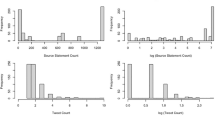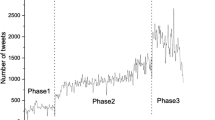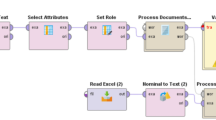Abstract
Retweeting is an important way of information propagation on Twitter. In this paper, we investigate the sentiment correlation between regular tweets and retweets. We anticipate our investigation sheds a light on how the sentiment of regular tweets impacts the retweets of different sentiments. We propose a method for measuring the sentiment of tweets. We categorize the Twitter users into different groups by different norms, which are the follower count, the betweenness connectivity, a combination of follower count and betweenness centrality, and the amount of tweets. Then, we calculate the sentiment correlation for different groups to examine the influential factors for retweeting a message with a certain sentiment. We find that the users with higher betweenness centrality and higher tweets amount tend to exhibit a higher sentiment correlation. The users with medium-level \(followers\_count\) show the highest sentiment correlation compared to the low-level and high-level \(followers\_count\). After combining the two factors of \(followers\_count\) and betweenness centrality, we discover that specifically at low-level betweenness centrality the users with medium-level \(followers\_count\) have the highest sentiment correlation. Our last observation is that the difference for correlation coefficients exists between different types of users. Our study on the sentiment correlation provides instructional information for modeling information propagation in human society.


Similar content being viewed by others
References
Almatarneh S, Gamallo P (2018) A lexicon based method to search for extreme opinions. PLOS ONE 13(5):1–19
Aparicio S, Villazón-Terrazas J, Álvarez G (2015) A model for scale-free networks: application to Twitter. Entropy 17:5848–5867
Bild DR, Liu Y, Dick RP, Mao ZM, Wallach DS (2015) Aggregate characterization of user behavior in Twitter and analysis of the retweet graph. ACM Trans Internet Technol 15(1):4:1–4:24
Blei DM, Ng AY, Jordan MI, Lafferty J (2003) Latent dirichlet allocation. J Mach Learn Res 3:2003
Bollen J, Mao H, Zeng X (2011) Twitter mood predicts the stock market. J Comput Sci 2(1):1–8
Breslin J, Decker S (2007) The future of social networks on the internet: the need for semantics. IEEE Internet Comput 11(6):86–90
Carchiolo V, Longheu A, Malgeri M (2015) Using Twitter data and sentiment analysis to study diseases dynamics. In: Proceedings of the 6th international conference on information technology in bio- and medical informatics. ITBAM 2015, vol 9267. Springer, New York, pp 16–24
Chen J, Li H, Wu Z, Hossain MS (2017) Sentiment analysis of the correlation between regular tweets and retweets. In: 2017 IEEE 16th international symposium on network computing and applications (NCA), pp 1–5
Chen J, Hossain MS, Brust MR, Johnson N (2018) A game theoretic analysis of the Twitter follow–unfollow mechanism. In: Bushnell L, Poovendran R, Başar T (eds) Decision and game theory for security. Springer, Cham, pp 265–276
Dahal B, Kumar SAP, Li Z (2019) Topic modeling and sentiment analysis of global climate change tweets. Soc Netw Anal Min 9(1):24
D’Andrea A, Ferri F, Grifoni P, Guzzo T (2015) Approaches, tools and applications for sentiment analysis implementation. Int J Comput Appl 125(3):26–33
Davidson I, Gourru A, Velcin J, Wu Y (2020) Behavioral differences: insights, explanations and comparisons of French and US Twitter usage during elections. Soc Netw Anal Min 10(1):6
Deshpande D (2016) Twitter user classification with gensim and scikit-learn. https://github.com/dsquareindia/twitter-user-classification
Hartline J, Mirrokni V, Sundararajan M (2008) Optimal marketing strategies over social networks. In: Proceedings of the 17th international conference on world wide web. WWW’08. ACM, New York, pp 189–198
Kamboj S, Kumar V, Rahman Z (2017) Social media usage and firm performance: the mediating role of social capital. Soc Netw Anal Min 7(1):51
Kay M (2014) Generating a network graph of twitter followers using python and network. http://mark-kay.net/2014/08/15/network-graph-of-twitter-followers/. 15 Aug
Keyvanpour M, Karimi Zandian Z, Heidarypanah M (2020) OMLML: a helpful opinion mining method based on lexicon and machine learning in social networks. Soc Netw Anal Min 10(1):10
Kwak H, Lee C, Park H, Moon S (2010) What is twitter, a social network or a news media? In: Proceedings of the 19th international conference on world wide web. WWW’10, ACM, New York, pp 591–600
Li Y, Li Q, Shan J (2017) Discover patterns and mobility of Twitter users—a study of four US college cities. ISPRS Int J Geo-Inf 6(2):42
Newman M (2010) Networks: an introduction. Oxford University Press Inc, New York
Nielsen FÅ (2011) A new ANEW: evaluation of a word list for sentiment analysis in microblogs. In: CEUR workshop proceedings, vol 718. CEUR-WS.org, pp 93–98
Pennacchiotti M, Popescu AM (2011) A machine learning approach to Twitter user classification. In: ICWSM
Pope D, Griffith J (2016) An analysis of online Twitter sentiment surrounding the european refugee crisis. In: Proceedings of the international joint conference on knowledge discovery, knowledge engineering and knowledge management. IC3K 2016. SCITEPRESS—Science and Technology Publications, Lda, Portugal, pp 299–306
Sadri AM, Hasan S, Ukkusuri SV, Suarez Lopez JE (2018) Analysis of social interaction network properties and growth on Twitter. Soc Netw Anal Min 8(1):56
Suh B, Hong L, Pirolli P, Chi EH (2010) Want to be retweeted? large scale analytics on factors impacting retweet in twitter network. In: Proceedings of the 2010 IEEE 2nd international conference on social computing. SOCIALCOM’10, Washington, DC, pp 177–184
Tumasjan A, Sprenger T, Sandner P, Welpe I (2010) Predicting elections with Twitter: what 140 characters reveal about political sentiment. In: Proceedings of the 4th international AAAI conference on weblogs and social media, pp 178–185
Vo BKH, Collier N (2013) Twitter emotion analysis in earthquake situations. Int J Comput Linguist Appl 4:159–173
Wilkinson DM (2008) Strong regularities in online peer production. In: Proceedings of the 9th ACM conference on electronic commerce. EC’08. ACM, New York, pp 302–309
Wilson C, Boe B, Sala A, Puttaswamy KP, Zhao BY (2009) User interactions in social networks and their implications. In: Proceedings of the 4th ACM European conference on computer systems. EuroSys’09. ACM, New York, pp 205–218
Wilson T, Hoffmann P, Somasundaran S, Kessler J, Wiebe J, Choi Y, Cardie C, Riloff E, Patwardhan S (2005) Opinionfinder: a system for subjectivity analysis. In: Proceedings of HLT/EMNLP on interactive demonstrations. HLT-Demo’05, pp 34–35
Xu Z, Yang Q (Aug 2012) Analyzing user retweet behavior on twitter. In: 2012 IEEE/ACM international conference on advances in social networks analysis and mining, pp 46–50
Zafarani R, Abbasi MA, Liu H (2014) Social media mining: an introduction. Cambridge University Press, Cambridge
Acknowledgements
We sincerely thank the anonymous reviewers whose suggestions helped improve this manuscript.
Author information
Authors and Affiliations
Corresponding author
Additional information
Publisher's Note
Springer Nature remains neutral with regard to jurisdictional claims in published maps and institutional affiliations.
Rights and permissions
About this article
Cite this article
Chen, J., Hossain, M.S. & Zhang, H. Analyzing the sentiment correlation between regular tweets and retweets. Soc. Netw. Anal. Min. 10, 13 (2020). https://doi.org/10.1007/s13278-020-0624-4
Received:
Revised:
Accepted:
Published:
DOI: https://doi.org/10.1007/s13278-020-0624-4




